The Imaging Resource
Quick Review
Olympus SP-350 Digital Camera
|
|||||||||||||||||||||
Introduction
|
||||||||
The Olympus SP-350 features a 8.0-megapixel CCD, 3x lens, the availability of full manual exposure control and a flash hot shoe in a pocket-friendly, compact size. In addition to the camera's automatic and manual controls, the SP-350 offers no less than 24 preset Scene modes, including a QuickTime Movie mode. With its small size, nice selection of creative controls, and high resolution sensor, the Olympus SP-350 is an excellent all-around camera suitable for novices and experienced amateurs alike.
User Report
by Shawn Barnett
When you first see the product shots of the Olympus SP-350, it's not impressive. Its big grip on the right really looks silly, especially in the front shot. Holding and using the camera, however, gives a very different impression.
The big grip gives you a far better hold on the camera than other small cameras in this class, yet the camera still travels well.
Two other factors changed my opinion of the Olympus SP-350 very quickly: the hot shoe and the printed image quality.
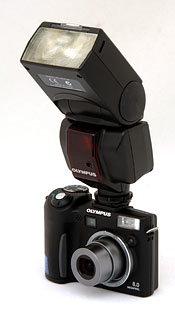 The SP-350 sat on my desk for about a week as I worked with other cameras. I kept looking at one part of the camera, but its significance didn't sink in until I finally started the review. It has a big hot shoe on top! I rummaged around in our equipment and found an Olympus FL-36 bounce flash. Now we're talking photography. The small flash looks somewhat monstrous on the small Olympus SP-350, causing it to tip over when the lens is extended, but flipping the flash head up into bounce mode, as shown at right, stabilizes it. Bounce position also transforms the camera's images from very good to excellent.
The SP-350 sat on my desk for about a week as I worked with other cameras. I kept looking at one part of the camera, but its significance didn't sink in until I finally started the review. It has a big hot shoe on top! I rummaged around in our equipment and found an Olympus FL-36 bounce flash. Now we're talking photography. The small flash looks somewhat monstrous on the small Olympus SP-350, causing it to tip over when the lens is extended, but flipping the flash head up into bounce mode, as shown at right, stabilizes it. Bounce position also transforms the camera's images from very good to excellent.
I had a great time getting pictures of the family that were a notch or two better than I normally get from a point and shoot. Sure the combo is bigger, but the better lighting is totally worth it. You can also tune the combination, switching the built-in flash on or off to act as fill or not. The only drawback with this is the significant increase shutter lag due to the FL-36's pre-flash pulse (designed to gauge proper flash exposure). The best aspect of digital is that you can check results and reshoot in seconds, and shooting extra doesn't cost you more than time.
Olympus makes a smaller flash, the FL-20, but it doesn't bounce, which is what I liked most. Still, with the FL-20, you'd go a long way toward eliminating red-eye.
The Olympus SP-350's printed image quality really blew us all away. For a small camera like this to produce decent quality 13x19 prints at ISO 400 is a significant milestone. You won't be able to do that with all subjects, because certain grays do still produce some noticeable color noise, but most photos print just great at 8x10, which is the maximum most people will expect. See the Print Quality section below for more.
The only complaints I have about the camera are the slow write time to both internal and external memory, and the more pronounced shutter lag than I'm used to. But if you're a patient photographer, or need a very good and small solution while traveling, you'll find the Olympus SP-350 a satisfying photographic tool.
Though the Olympus SP-350 is compact, it packs in a lot of detailed features, including full manual exposure control, 24 preset Scene modes, an 8.0-megapixel CCD, and a large, 2.5-inch LCD monitor. The SP-350's compact dimensions are perfectly suited for shirt pockets and small purses, with an automatic lens cover that makes it quick on the draw as well. The included neck strap is handy when shooting over a boat rail or while riding on a ski lift, but I'd recommend picking up a soft case to protect the SP-350's flat-black body panels from scratches.
The Olympus SP-350 features a 3x, 8-24mm zoom lens (equivalent to a 38-114mm lens on a 35mm camera). Maximum aperture ranges from f/2.8 to f/4.9, depending on the zoom setting. A set of lens threads lets you connect Olympus' accessory conversion lenses, extending the camera's wide angle and telephoto capabilities. The SP-350 employs an efficient contrast-detection autofocus system, with focus ranging from 7.9 inches (20 centimeters) to infinity in normal mode. A Macro setting focuses as close as 11.8 inches (30 centimeters). There's also a Super Macro option that gets as close as 0.8 inches (2.0 centimeters), for real close-in shooting. By default, the camera uses an iESP autofocus area setting, which automatically sets the focus based on the subject's proximity to a range of AF points around the center of the image area. Through the Record menu, you can opt for a Spot AF setting, which will instead base focus only on the very center of the frame. There's also an Area AF mode, which lets you manually position the AF area just about anywhere in the frame. In addition to its 3x optical zoom, the Olympus SP-350 also offers 5x Digital Zoom. Keep in mind though, that digital zoom simply enlarges the center pixels of the CCD and thus results in lower image quality. The 8.0-megapixel CCD produces high-resolution images, good enough for prints up to 16x20 inches with good detail and sharpness, as well as lower-resolution images for sending via email or for printing 5x7- and 4x6-inch prints.
For composing images, the SP-350 offers a real-image optical viewfinder and 2.5-inch TFT color LCD monitor, which features a very bright and clear display. The optical viewfinder has no dioptric adjustment, and a slightly low eyepoint. The LCD monitor provides a fairly detailed exposure-information display, and a histogram option is available for checking the exposure graphically. There's also a framing guideline option, which divides the image area into thirds horizontally and vertically, or adds diagonal lines, to help you line up difficult shots. In Playback mode, the LCD monitor provides image enlargement and an index display. And the SP-350 also features a helpful Guide button. Hold down the Guide button when in menus and the screen displays a context sensitive help message. With the Olympus SP-350, you're never lost and don't have to remember what everything means. Just press the Guide button.
Exposure control on the Olympus SP-350 is uncomplicated and straightforward, despite its full manual exposure control offering. The camera offers a range of exposure control modes, enabled by turning the Mode dial, as well as a wide selection of preset Scene modes for specific shooting situations. Most of the exposure options are controlled through the multi-page LCD menu system, which is fairly simple to navigate. An initial shortcut menu screen pops up before entering the main Record menu, offering quick-access options for the camera's White Balance, Image Size, and Macro, or you can choose to just enter the main Record menu itself. The SP-350 offers full Auto, Program AE, Aperture Priority, Shutter Priority, and Manual main exposure modes. Shutter speeds range from 1/2,000 to 15 seconds, with a maximum eight-minute bulb option available as well. In addition to the available shutter speed and aperture settings, the user can also adjust Exposure Compensation (to lighten or darken the image), ISO (the camera's sensitivity to light), White Balance (to adjust the color), a white balance adjustment tool, Metering (to read light from the whole frame or just the center), and Flash modes. The Olympus SP-350's built-in flash operates in Auto, Red-Eye Reduction, Fill, and Off modes. There's also an external flash hot shoe, for attaching a more powerful flash unit. Through the Picture tab of the record menu, you can also adjust contrast, saturation, and sharpening.
The Olympus SP-350's Scene mode (accessed by turning the Mode dial to the Scene position) offers Portrait, Landscape, Landscape + Portrait, Night Scene, Sport, Night + Portrait, Indoor, Candle, Self Portrait, Available Light Portrait, Sunset, Fireworks, Museum, Behind Glass, Cuisine, Documents, Auction, Shoot & Select 1, Shoot & Select 2, Beach, Snow, Underwater Wide 1, Underwater Wide 2, and Underwater Macro. Each mode on the Olympus SP-350 sets up the camera for specific shooting situations, and a concise explanation of each mode appears on the LCD screen as you scroll through. Most of the preset modes are fairly self-explanatory, as they handle very distinct situations. However, the Shoot & Select modes deserve some explanation. Both take a sequence of shots but Shoot & Select 1 locks focus on the first frame (great for faces) while Shoot & Select 2 adjusts focus for each frame (better for sports and action shots). When you've finished the sequence, the images are displayed so you can delete the unwanted ones. Another option on the Mode dial is the My mode, which lets you save as many as four sets of custom settings.
Other camera features include a Self-Timer mode, which provides a 12-second delay between the time the Shutter button is pressed and the image is actually captured. The SP-350 features three Sequential Shooting modes, which let you capture a rapid series of images while holding down the Shutter button. Actual frame rates and the total number of images will depend on the image size and quality settings, as well as the amount of available space on the memory card, but the burst length is limited to about four shots in large/fine mode. A High Speed Sequential option captures images at a faster frame rate, while an AF Sequential option sets the focus before each shot, thus slowing down the cycle time. As with many Olympus cameras, a Panorama mode is available on the SP-350 when using Olympus brand xD-Picture Card storage cards (but not cards from third parties), and records as many as 10 consecutive images to blend into one panoramic image. There's also a 2in1 mode for capturing two images displayed side-by-side in a full resolution file, and a Timelapse Photography mode for capturing a series of images at preset intervals. The camera's Movie mode captures moving images with sound, at either 640 x 480 or 320 x 240 pixels, at 15 or 30 frames per second. Maximum recording time depends on the resolution and available memory space. Another interesting feature on the Olympus SP-350 Digital is the ability to save images in groups or albums. You can save as many as 12 albums, each containing a maximum of 200 images. The Album option in the Playback menu accesses saved albums, letting you select one for playback.
The Olympus SP-350 stores images on xD-Picture Cards, but does not ship with one. It does have 25MB internal memory, but you'll want to get a card along with the camera so you don't miss any important shots. Large capacity xD Picture cards are available up to 1GB, and I suggest buying at least a 256MB xD-Picture Card. A CD-ROM loaded with Olympus' Camedia Master software accompanies the camera, compatible with both Windows and Macintosh platforms (including Windows XP and Mac OS X). Camedia Master provides minor image editing tools, and the ability to "stitch" together multiple images shot in panorama mode, as well as utilities for organizing images. A second CD-ROM holds the SP-350's more advanced instruction manual, which is more detailed than the basic manual that's included in book form. For power, the camera uses either two AA-type batteries or a single CR-V3 battery pack. I'd recommend picking up a set of rechargeable batteries and keeping two charged at all times. Read my NiMH battery shootout page to see which batteries currently on the market are the best, and see my review of the Maha C-204W NiMH battery charger, my current favorite. The optional AC adapter is recommended for time-consuming tasks such as transferring images to a computer. Also included with the Olympus SP-350 is an AV cable for connecting to a television set, and a USB cable for connecting the camera to your computer to transfer images.
Basic Features
- 8.0-megapixel CCD
- 2.5-inch color LCD display
- Real image optical viewfinder
- 3x, 8-24mm zoom lens (equivalent to a 38-114mm lens on a 35mm camera), with threaded barrel for conversion lenses
- 5x Digital zoom
- Aperture range from f/2.8 to f/8
- Shutter speeds from 1/2,000 to 15 seconds, with a Bulb setting (maximum eight seconds)
- Automatic, Program, Aperture Priority, Shutter Priority, and Manual exposure control, with 24 preset Scene modes
- Built-in flash with five operating modes
- External flash hot shoe
- xD-Picture Card storage, plus 25MB internal memory
- Power supplied by two AA-type batteries, single CR-V3 battery, or optional AC adapter
- Olympus Camedia Master software for both Mac and Windows
Special Features
- TruePic TURBO Image Processor
- A Guide button for help in most menus
- Live histogram and grid overlay
- Macro and Super Macro lens adjustment
- Noise reduction for long exposures
- Panorama mode for stitching together multiple images
- "2 in 1" multi-exposure and Timelapse photography modes
- White balance (color) adjustment with eight preset modes and a manual setting, and a fine tuning adjustment
- Digital ESP (full frame), Center-Weighted, and Spot exposure metering options
- Adjustable ISO to 50, 100, 200, or 400 equivalents, plus an Auto setting
- Normal, High Speed, and AF Sequential Shooting modes
- QuickTime movies (with sound)
- "Calendar" organization of captured images
- "Album" organization for favorite photos
- DPOF (Digital Print Order Format), PRINT Image Matching III, and PictBridge compatibility
- DCF (Design rule for Camera File system) compatibility
- Exif 2.2 compatibility
- USB 2.0 Full Speed with AutoConnect (no driver software needed) and USB cable
- Video cable for connection to a television set
Recommendation
The Olympus SP-350 offers full manual exposure control and an 8.0-megapixel CCD, as well as very user friendly preset Scene modes and the convenience of point-and-shoot operation. With its small dimensions, understated stylish design, and a nice array of features, the SP-350 could be a good match for novices and more experienced amateurs alike. You get a large, bright 2.5-inch LCD monitor, a good-quality lens, and an excellent selection of shooting options, making the camera very versatile in a variety of situations. Novices will appreciate the ability to gradually step up exposure control, while more experienced photographers will enjoy the full manual control in a small package.
The Olympus SP-350 is something of a dichotomy: while it's quite narrow at one end, it tapers out to a big grip, an unusual shape, but it emphasizes the camera's big capabilities in a small package. Measuring 3.9 x 2.6 x 1.4 inches (99 x 65 x 35 millimeters), and weighing only 255 grams (9 ounces) with batteries and memory card, the SP-350 is perfect for travelers. Although the camera is quite small, it fits the hand very well, and the sculpted handgrip is substantial enough for a firm hold, and the hot shoe can accept Olympus's FL-36 bounce flash for a more professional look.
The Olympus SP-350's front panel contains the 3x zoom lens, built-in flash, and the self-timer / AF assist lamp. Also visible is the optical viewfinder window, with the camera's microphone just beside it. The inside lip of the lens barrel is threaded, for attaching the optional accessory lenses. A shutter-like lens cover automatically opens when the camera is powered on, allowing the lens to extend. The right handgrip is large enough for a good hold, and features a rubbery strip on its inside edge for fingers to cling to.
On top of the Olympus SP-350's right side is the tight wrist strap eyelet, which requires some finesse to slip the wrist strap through. Below that is a rubbery, plastic compartment door for the Video Out / USB and DC In connector jacks. Just below is the xD-Picture Card compartment, beneath a hinged plastic door.
The opposite side of the Olympus SP-350 is featureless, except for the secondary neck strap eyelet.
The top of the Olympus SP-350 features the Shutter button, surrounded by the Zoom lever, as well as the Mode dial and external flash hot shoe. A removeable plastic insert protects the hot shoe contacts.
The few remaining external controls are located on the Olympus SP-350's rear panel, along with the large, 2.5-inch, TFT color LCD monitor and optical viewfinder eyepiece. Next to the optical viewfinder are two small LEDs, that light to indicate focus and flash status. Above the top right corner of the LCD monitor are the Power, Flash/Erase, and AE Lock/Print buttons. The Display/Guide and QuickView buttons extend down the right side of the display. A Four-Way Arrow pad is in the lower right corner, with the OK/Menu button at its center. Its four arrows serve not only as navigational tools, but also adjust camera settings like Exposure Compensation, Flash, Macro, and Self-Timer modes.
The Olympus SP-350 has a reasonably flat bottom panel, featuring the camera's speaker, plastic threaded tripod mount, and the battery compartment. The tripod mount is too close to the battery compartment to allow quick changes when shooting with a tripod, though this likely isn't much of a concern for most users of this camera, given its very portable design.
The SP-350's user interface offers a wide range of exposure control options, though relatively few external buttons. As a result, learning to use the camera shouldn't take too much time. Pressing the power button opens the lens cover and extends the lens, while the Mode dial sets the camera's operating mode. The Four-Way Arrow pad on the back panel serves several functions and navigates through on-screen menus. It also scrolls through captured images in Playback mode. The LCD menu system accesses the rest of the Olympus SP-350's exposure options (like ISO, White Balance, Resolution, etc.). Even first-time beginners should get the gist of it after a few minutes.
Record Mode Display: The Olympus SP-350's Record mode screen always shows an information overlay that displays the exposure mode, flash mode, ISO, image quality, exposure information, and shots remaining on the memory card, among other camera and exposure settings. A brief battery icon also displays in the upper left corner, reporting the approximate charge level. Pressing the Display/Guide button cancels the information overlay except for the focus brackets. A third press returns the information display, while the fourth dismisses the LCD entirely. You can optionally enable a live histogram display (which replaces the pixel dimensions in the information overlay) or a "Direct" display, which highlights any strong highlights or shadows in the display.
Playback Mode Display: In Playback mode, you can choose to have more or less image information shown in the overlay display; but regardless of the amount chosen, the overlay disappears after a few seconds of not touching the controls, so you can always (eventually) see just the photo itself. A press of the Olympus SP-350's Display button blinks any overblown highlights. Using the zoom control, you can zoom out to a thumbnail display showing four, nine, 16, or 25 images at once, a calendar view, or zoom in and check fine details or focus.
External Controls
Shutter Button: Sitting far forward on the SP-350's top panel, this button sets focus and exposure when halfway depressed. Fully depressing the button triggers the shutter to open.
Zoom Lever (see image above): Surrounding the Shutter button on the top panel, this lever controls the optical and digital zoom (when the latter is enabled) in any record mode. In Playback mode, this button controls the digital enlargement of captured images and also accesses the index display modes.
Exposure Mode Dial: Behind the Shutter button on the top panel, this notched dial controls the camera's operating mode. Choices are Auto, Program AE, Aperture Priority, Shutter Priority, Manual, My Mode, Scene, and Movie exposure modes, as well as Playback mode.
Power Button : Tiny and recessed into the Olympus SP-350's rear panel next to the optical viewfinder, this button turns the Olympus SP-350 on and off. When turned on, the camera extends the lens into its operating position (unless the Mode dial is set to Playback).
Flash/Erase Button: Directly right of the Power button, this button cycles through the available flash modes in Record mode. In Playback mode, this button displays the erase menu.
AE Lock/Print Button: Right of the Flash/Erase button, this button locks the exposure independently of focus when pressed in Record mode, and holds the setting until the button is pressed again or the shutter is fired. In Playback mode, this button enables direct printing when the camera is connected to a printer.
Display/Guide Button : Adjacent to the top right corner of the LCD monitor, this button cycles through the Olympus SP-350's LCD display modes, showing more or less information with each press. It also serves as the Guide button, activating a help screen for most menu items when held down.
Quickview Button: Below the Display/Guide button, this button displays the most recently captured image on the LCD monitor.
Four-Way Arrow Pad : Dominating the lower right corner of the rear panel, four arrow buttons point in a different direction (up, down, left, right). In any mode, the arrow keys navigate through the Olympus SP-350's menu options. In Program AE, Aperture Priority, and Shutter Priority, the left and right buttons control the Exposure compensation. In Aperture and Shutter Priority modes, the up and down buttons adjust the available exposure variable. In Manual mode, the left and right buttons control the aperture setting, while the up and down buttons adjust the shutter speed.
In Playback mode, the Right and Left arrows scroll through captured images. When an image has been enlarged with the zoom control, all four arrows navigate within the view.
Menu / OK Button (see image above): In the center of the arrow pad, this button calls up the settings menu in both Record and Playback modes. It also serves as the "OK" button to confirm menu selections.
Camera Modes and Menus
Auto Exposure Mode: Accessed by turning the Olympus SP-350's Mode dial to the Auto position, this mode puts the camera in charge of the full exposure, with the user only able to adjust zoom, flash, and image quality and size settings.
Program AE Mode: A simple "P" marks this mode on the Mode dial. Here, the camera maintains control over the actual exposure, while the user can adjust all other settings.
Aperture Priority Mode: The letter "A" indicates this mode on the Mode dial, which puts the user in control of the aperture setting, while the camera selects the most appropriate corresponding shutter speed.
Shutter Priority Mode: Opposite of Aperture Priority mode, this mode puts the user in charge of the shutter speed, while the camera selects the best aperture setting.
Manual Mode: Marked with an "M" on the Mode dial, this mode puts the user fully in control of all camera settings.
My Mode: This mode allows the user to register a set of custom camera settings, for quick recall later.
Scene Mode: Indicated by the word "Scene" on the Mode dial, this mode provides access to no less than 24 preset Scene modes. Each choice is accompanied by an example photograph and an explanation of the mode's purpose (rather than show all of them at right, we're showing the first five as an example). Choices are: Portrait, Landscape, Landscape + Portrait, Night Scene, Sport, Night + Portrait, Indoor, Candle, Self Portrait, Available Light Portrait, Sunset, Fireworks, Museum, Behind Glass, Cuisine, Documents, Auction, Shoot & Select 1, Shoot & Select 2, Beach, Snow, Underwater Wide 1, Underwater Wide 2, and Underwater Macro.
Movie Mode: A small icon of a movie camera indicates this mode on the Mode dial. Movie mode records moving images with sound, for as long as the internal memory or memory card has available space.
Playback Mode: The Playback symbol on the Mode dial indicates the camera's review mode, which displays images and movies. Images can be set up for printing, enlarged, viewed in an index or calendar display, or resized.
Record Menu: The following menu options are accessible by pressing the OK/Menu button in record mode, though all options may not be available in all modes. A shortcut menu appears first, for quick access to the camera's White Balance, Quality, and Macro options. The Mode Menu option displays the full menu.
White Balance: Sets the color balance to Auto, Preset (Daylight, Cloudy, Sunset, Incandescent, Fluorescent 1 [Daylight], Fluorescent 2 [Neutral], or Fluorescent 3 [Cool]), or Manual options.
- Image Size/Quality: Sets the image resolution and quality level. Choices are:
- RAW: Records all information from the CCD at full resolution, you can record a single RAW image, or one in conjunction with a JPEG image at either SHQ, HQ, SQ1, or SQ2 quality settings.
- SHQ (Super High Quality): Records images at 3,264 x 2,448 or 3,264 x 2,176 (3:2 ratio).
- HQ (High Quality): Also records at either 3,264 x 2,448 and 3,264 x 2,176 (3:2 ratio) resolutions.
- SQ1 (Standard Quality): Offers 2,592 x 1,944; 2,288 x 1,712; 2,048 x 1,536; and 1,600 x 1,200 resolutions, each with High and Normal quality settings.
- SQ2: Offers 1,280 x 960; 1,024 x 768; and 640 x 480 pixels, also at High and Normal quality settings.
- Macro: Enables Macro or Super Macro modes.
- Mode Menu: Displays the following three-page, tabbed menu system:
Camera:
- Metering: Controls the camera's exposure metering system, selecting either Digital ESP (multi-pattern metering), Center-Weighted, or Spot (reads only from the center of the frame).
- Macro: Enables the Macro or Super Macro modes.
- Drive: Selects One-Shot, Sequential (Continuous) Shooting, High Speed Sequential, AF Sequential, or Auto Exposure Bracketing capture modes.
- ISO: Sets the camera's sensitivity to Auto, or to 50, 100, 200, or 400 equivalents.
- Self-Timer: Turns the self-timer mode on or off.
Flash Exposure Compensation: Adjusts the built-in flash power from -2 to +2.
- Flash Syncro: Sets the Slow-Syncro flash mode to fire with the first or second curtain.
- External Flash: Controls the behavior of the external flash. Options include the internal and external flash, the external flash only, or Slave, which sets the external flash to control other flash units.
- Noise Reduction: Turns the camera's Noise Reduction option on or off.
AF Mode: Lets you choose the autofocus area, either iESP, Spot, or Area.
- Focus Mode: Puts the focus into auto or manual focus modes.
- Fulltime AF: Turns Fulltime AF on or off.
- Digital Zoom: Turns digital zoom on or off.
- Panorama: Available only with Olympus brand cards, this mode captures as many as 10 consecutive shots to be stitched together on a computer into one panoramic image. Alignment guidelines appear on the screen to perfectly line up each shot.
- Voice Memo: If enabled, this lets you record a short sound clip to accompany an image.
Timelapse: Enables the Timelapse photography mode. If enabled, you can set the number of pictures (from two to 99), as well as the interval between shots (from one to 99 minutes).
- Picture:
Image Size/Quality: Sets the image resolution and quality level. Choices are:
- RAW: Records all information from the CCD at full resolution, you can record a single RAW image, or one in conjunction with a JPEG image at either SHQ, HQ, SQ1, or SQ2 quality settings.
- SHQ (Super High Quality): Records images at 3,264 x 2,448 or 3,264 x 2,176 (3:2 ratio).
- HQ (High Quality): Also records at either 3,264 x 2,448 and 3,264 x 2,176 (3:2 ratio) resolutions.
- SQ1 (Standard Quality): Offers 2,592 x 1,944; 2,288 x 1,712; 2,048 x 1,536; and 1,600 x 1,200 resolutions, each with High and Normal quality settings.
- SQ2: Offers 1,280 x 960; 1,024 x 768; and 640 x 480 pixels, also at High and Normal quality settings.
- White Balance: Sets the color balance to Auto, Preset (Daylight, Cloudy, Sunset, Incandescent, Fluorescent 1 [Daylight], Fluorescent 2 [Neutral], or Fluorescent 3 [Cool]), or Manual options.
- White Balance +/-: Adjusts the white balance by adding more red or blue in arbitrary increments.
- Sharpness: Controls the overall image sharpness, from -5 to +5 in arbitrary units.
- Contrast: Adjusts the image contrast from -5 to +5.
- Saturation: Increases or decreases the overall color saturation, from -5 to +5.
- Memory:
Memory Format: Formats the xD-Picture Card or internal memory, erasing all files (even write-protected ones).
- Setup:
Reset: Resets all of the camera settings to their defaults.
- Language: Sets the menu language to English, French, Spanish, or Portuguese.
- Power On Setup: Selects the picture displayed when the camera is turned on, as well as the sound. You can also register your own picture for display at power up.
- Power Off Setup: Selects the picture or screen displayed when the camera is powered off. You can also select a shutoff sound.
- Record View: Turns the instant image review on or off. When activated, instant image review briefly displays the just-captured image after you trip the shutter.
Volume: Controls the speaker volume, with choices of Off, Low, or High.
- Beep: Controls the camera's beep sounds. You can choose between two sounds, with Low and High volume options.
- Shutter Sound: Assigns the shutter sound, with two options and a volume setting.
- My Mode Setup: Lets you reset the My Mode settings, or create a new bank of settings.
- File Name: Allows user to reset the file name counter.
Pixel Mapping: Checks the camera's CCD and image processing functions, maps out bad pixels. (You shouldn't need to do this more than once a year or so.)
- LCD Brightness: Adjusts the brightness level of the LCD monitor display.
- Date/Time: Sets the camera's internal clock and calendar.
- Dual Time Setup: Useful for setting and keeping time in different time zones.
- Meters/Feet: Sets the manual focus measurement to meters or feet.
Video Out: Sets the camera's Video Out signal timing to either NTSC or PAL.
- AF Illuminator: Turns the AF assist lamp on or off.
- Short Cut: Sets the short cut icons for the shortcut menu.
- Histogram: Enables histogram display option, as well as a Direct setting, which flashes over or underexposure areas.
- Frame Assist: Sets the frame assist to either horizontal and vertical lines or diagonal lines, or disables it.
Custom Button: Customizes the function of the AE Lock/Print button, to one of a list of exposure options.
Playback Menu: The following playback options are available through the Olympus SP-350's Playback settings menu:
Edit: Goes straight to image editing menu tab.
- Album Entry: Displays the album setup screen. Here, you can select images to file in one of the 12 albums. You can also select an image to display as a thumbnail in a graphical calendar display.
- Calendar: Goes straight to calendar menu.
- Mode Menu: Displays the following four-page menu:
- Play:
Protect: Write-protects (or removes protection) from the currently displayed image. Write-protection locks the image file so you can't accidentally erase it or change the file in any way (except by formatting the card).
- Rotate: Rotates the displayed image 90 degrees clockwise or counterclockwise.
- Playback: Provides Normal (one at a time), Fader (next picture fades in), Slide (next picture slides in from the top of the screen), and Zoom (next pictures grows from top left of the screen) automatic playback options.
- DPOF: Marks the displayed image, or all images on the card, for printing on a DPOF (Digital Print Order Format) compatible printer. You can also establish the number of prints, whether or not the date and time are printed over the image, or remove the print mark.
- Sound Memo: Records a short sound clip to accompany the displayed image.
- Edit:
RAW Data Edit: Allows minor editing of RAW data files.
- Resize: Allows you to resize the displayed image to a smaller resolution. The resized image is saved as a separate file. (Handy for photos you want to email.)
- Trimming: Lets you crop an image and save it as a separate file.
- Red-Eye Fix: Removes red-eye, saving the image to a new file.
- Black & White: Converts the displayed image to black-and-white and saves it as a new file.
Sepia: Converts the displayed image to sepia tone, giving it the appearance of an old-fashioned picture, and saves the converted image as a new file.
- Frame: Adds a frame to the current image and saves it as a new file.
- Title: Adds a title to the current image and saves it as a new file.
- Calendar: Adds the current image to a calendar and saves it as a new file.
- Layout: Offers a selection of page layouts for the camera's Album feature.
Brightness: Adjusts the brightness of the current image.
- Saturation: Adjusts the saturation of the current image.
- Memory/Card (one or the other depending on whether there's an xD card inserted):
All Erase: Erases all files (even write-protected ones).
- Format: Formats the xD-Picture Card or internal memory, erasing all files (even write-protected ones).
- Setup (similar to Record menu above):
- Reset: Resets all of the camera settings to their defaults.
- Language: Sets the menu language to English, French, Spanish, or Portuguese.
- Shooting Mode Button Power On: Enables the Shooting Mode button to also power the camera On or Off.
- Power On Setup: Selects the picture displayed when the camera is turned on. You can also register your own picture for display at power up.
- Power Off Setup: Selects the picture or screen displayed when the camera is powered off. You can also select a shutoff sound.
- Screen Setup: Selects a saved image to be used in the Power On or Power Off setup.
- Volume: Adjusts the camera's speaker volume.
- Sound: Adjusts the camera's indicator volume.
- Beep: Controls the camera's beep sounds. You can choose between two sounds, with Low and High volume options.
- LCD Brightness: Adjusts the brightness level of the LCD monitor display.
- Date/Time: Sets the camera's internal clock and calendar.
- Dual Time Setup: Useful for setting and keeping time in different time zones.
- Video Out: Sets the camera's Video Out signal timing to either NTSC or PAL.
- Play:
In the Box
The Olympus SP-350 Digital ships with the following items in the box:
- SP-350 Digital camera
- Neck strap
- USB cable
- Video cable
- Two AA-type batteries
- CD-ROMs loaded with Olympus Master software, drivers, and instruction manuals.
- Basic manual, Quick Start guide and registration kit
- A large capacity xD-Picture Card (at least 256MB)
- AC Adapter
- Rechargeable batteries and charger
- Small camera case for protection
Recommended Software: Rescue your Photos!
Just as important as an extra memory card is a tool to rescue your images when one of your cards fails at some point in the future. We get a lot of email from readers who've lost photos due to a corrupted memory card. Memory card corruption can happen with any card type and any camera manufacturer, nobody's immune. A lot of "lost" images can be recovered with an inexpensive, easy to use piece of software though. Given the amount of email I've gotten on the topic, I now include this paragraph in all my digital camera reviews. The program you need is called PhotoRescue, by DataRescue SA. Read our review of it if you'd like, but download the program now, so you'll have it. It doesn't cost a penny until you need it, and even then it's only $29, with a money back guarantee. So download PhotoRescue for Windows or PhotoRescue for Mac while you're thinking of it. (While you're at it, download the PDF manual and quickstart guide as well.) Stash the file in a safe place and it'll be there when you need it. Trust me, needing this is not a matter of if, but when... PhotoRescue is about the best and easiest tool for recovering digital photos I've seen. (Disclosure: IR gets a small commission from sales of the product, but I'd highly recommend the program even if we didn't.) OK, now back to our regularly scheduled review...
See camera specifications here.
Cycle times, shutter lag, battery life, etc. can be found here.
We ran the Olympus SP-350 through our usual battery of tests, and have summarized our findings here. To see the full set of our test images, with explanations of what to look for in them, see the Olympus SP-350 Sample Pictures page. For a complete listing of all our test and "gallery" shots, go to the Thumbnails page.
A collection of more random, pictorial images can be found in the Olympus SP-350 Photo Gallery.
Not sure which camera to buy? Let your eyes be the ultimate judge! Visit our Comparometer(tm) to compare images from the Olympus SP-350 with those from other cameras you may be considering. The proof is in the pictures, so let your own eyes decide which you like best!
Lens
Zoom
A typical 3x optical zoom range, with good performance.
38mm |
114mm |
5x Digital Zoom |
The Olympus SP-350 zooms over the equivalent of a 38-114mm range, fairly typical for its class. Details are sharp and clear at full wide angle, and coma distortion is minimal. The 5x digital zoom takes it out to 15x total, though with the loss of quality you'd expect (lower resolution and softer details).
Macro
About average performance in the normal mode, but a very tiny area in Super Macro mode. Flash exposes fairly well, though a little uneven.
| Standard Macro | Macro with Flash | Super Macro |
The Olympus SP-350's normal macro setting performs about average, capturing a minimum area of 4.52 x 3.39 inches (115 x 86 millimeters). Detail is strong and resolution high, with only minimal softening in the corners from the lens. (Most cameras have some softening in the corners in macro mode.) In Super Macro mode, however, the minimum area is quite small, measuring 1.00 x 0.75 inches (26 x 19 millimeters), also with excellent detail. The flash throttles down pretty well, though lighting is uneven, with falloff in the corners of the frame.
Distortion
High barrel distortion and moderate pincushion.
This is the tendency for the lens to bend straight lines outward (like a barrel--usually at wide angle) or inward (like a pincushion--usually at telephoto). The Olympus SP-350's 1.0% barrel distortion at wide angle is higher than average among digital cameras we've tested, and its 0.3% pincushion at telephoto is also a little more than we'd like to see.
| Barrel distortion at 38mm is 1.0% |
| Pincushion at 114mm is 0.3% |
Chromatic aberration
High at wide angle, though very low at telephoto.
 |
 |
| Wide: high and bright, top left @ 200% | Wide: bright, top right @ 200% |
 |
 |
| Tele: quite low, top left @200% | Tele: quite low, top right @200% |
Chromatic aberration is rather high at wide angle, showing several pixels of very bright coloration on either side of the target lines, but decreases to very low levels at telephoto focal lengths. (This distortion is visible as a very slight colored fringe around the objects at the edges of the field of view on the resolution target.)
Corner Sharpness
Some softening in the in the left corners of the frame, with moderate softening in the right corners as well.
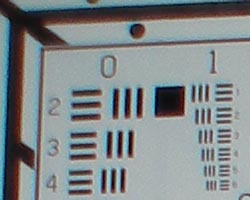 |
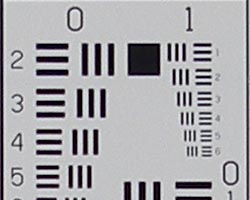 |
| Wide: soft in the upper left corner. | Wide: fairly sharp at center. |
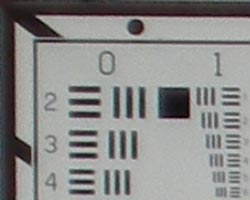 |
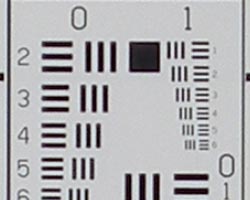 |
| Tele: soft in the upper left corner. | Tele: slightly soft at center. |
The Olympus SP-350 produced fairly soft corners in a few shots, though the left corners showed the strongest effect at both wide angle and telephoto. Given the camera's 8 megapixel resolution, this softening won't likely be apparent at most print sizes.
Sensor
Exposure and White Balance
Indoors, incandescent lighting
Slight warm cast with Manual and Incandescent white balance settings, though still good color. Average exposure compensation required.
| Auto White Balance +1.0 EV | Incandescent WB +1.0 EV |
| Manual White Balance +1.0 EV |
Color balance indoors under incandescent lighting was just a bit warm and reddish in Auto white balance mode, though the Manual and Incandescent settings both produced more accurate results. The Olympus SP-350 required a +1.0 EV exposure compensation boost to get a good exposure, which is about average for this shot. Overall color looks good, though a hint dark, making the blue flowers dark and purplish. (A very common outcome for this shot.) Our test lighting for this shot is a mixture of 60 and 100 watt household incandescent bulbs, a pretty yellow light source, but a very common one in typical home settings here in the US.
Outdoors, daylight
Slightly warm color balance outdoors in Auto mode, high contrast under harsh lighting.
| Auto White Balance, +1.3 EV | Auto White Balance, Auto Exposure |
Outdoors, the SP-350 tended toward warmer color with the Auto white balance setting, and tended to produce high contrast under harsh lighting. Highlight detail was cut, but shadow detail was not bad. Overall, the camera required slightly more positive exposure compensation than average to bring up the midtones.
It should be noted that this is a test of the camera's ability to handle extreme lighting situations. We recommend moving your subjects into the shade and letting surrounding light fall on them (from a big building, say) rather than putting them in such harsh lighting; if you must get a shot like this, switch to force flash mode to fill in those shadows.
See full set of test images with explanations
See thumbnails of all test and gallery images
Resolution
High resolution, 1,300 - 1,400 lines of strong detail.
Our laboratory resolution chart revealed impressively sharp, distinct line patterns down to about 1,300 lines per picture height, 1,400 per picture width with extinction at around 1,800. (The camera did produce very slight color artifacts at lower line frequencies, barely visible in the full-sized res target shots.) Use these numbers to compare with other cameras of similar resolution, or use them to see just what higher resolution can mean in terms of potential detail. Beware that while you might be able to make out what looks like distinct lines at numbers higher than those we've mentioned here, the camera is just doing its best to continue interpreting the lines. If you zoom in and follow them from the wider portions, you'll see the lines converge and reappear several times, so the lines you see at 1,800 and higher are really only artifacts generated by the camera's imaging system.
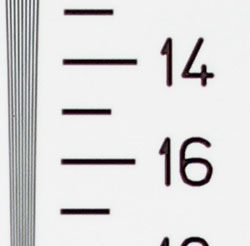 |
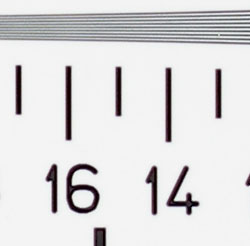 |
| Strong detail to 1,400 lines horizontal | Strong detail to 1,300 lines vertical |
See full set of test images with explanations
See thumbnails of all test and gallery images
Sharpness & Detail
Fairly sharp images, with some blurring of detail from noise suppression, as well as some over-sharpening in high contrast areas.
The Olympus SP-350's images are reasonably sharp, though with noticeable over-sharpening and edge enhancement in high contrast areas, such as the door frame above. (Edge enhancement creates the illusion of sharpness by enhancing colors and tones right at the edge of a rapid transition in color or tone.)
Noise-suppression systems in digital cameras tend to flatten-out detail in areas of subtle contrast. The effects can often be seen in shots of human hair, where the individual strands are lost and an almost "watercolor" look appears. The crop at far right shows this, with darker areas of Marti's hair showing only limited detail, even though individual strands are quite visible against her cheek in the uncropped image.
ISO & Noise Performance
Low noise at the normal sensitivity settings, high noise that blurs detail at the higher settings.
| ISO 50 | ISO 100 |
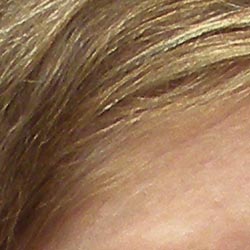 |
|
| ISO 200 | ISO 400 |
The Olympus SP-350's lower ISO settings produced low to moderate noise, with only slightly blurred detail in the dark areas. As the ISO setting increases, so does the noise level and the amount of blurring that results, and its images at ISO 400 are much softer, with brighter noise pixels. Color noise has been kept under control surprisingly well, and one can print very good 11x14s even at ISO 400 (See Output Quality section below).
Extremes: Sunlit and low light tests
High resolution with good overall detail, though high contrast and limited shadow detail. Pretty good low-light performance, capable of capturing bright images under average city street lighting and slightly darker conditions.
| +0.7 EV | +1.0 EV | +1.3 EV |
Sunlight:
Because digital cameras are more like slide film than negative film (in that they tend to have a more limited tonal range), we test them in the harshest situations to see how they handle scenes with bright highlights and dark shadows, as well as what kind of sensitivity they have in low light. The shot above is designed to mimic the very harsh, contrasty effect of direct noonday sunlight, a very tough challenge for most digital cameras. (You can read details of this test here.)
The Olympus SP-350 had a little trouble with the deliberately harsh lighting in the test above, producing very high contrast with washed-out highlights and deep shadows. Both shadow and highlight detail are limited, with noise suppression evident in the shadow areas. Exposure is slightly washed out at +1.3 EV, but best overall. (In "real life" though, be sure to use fill flash in situations like the one shown above; it's better to shoot in the shade when possible.)
Low light:
Our low light testing revealed some limitations in the lens and sensor's ability to gather and process light, but the Olympus SP-350 captured bright images to the lowest light level we test at: the 400 ISO setting. However, at ISO 50, images were bright only to 1/4 foot-candle, about 1/4 as bright as average city street lighting at night. Color balance was warm from the Auto white balance setting. The camera's autofocus system was slightly limited without the AF assist lamp, able to focus on the subject down to the 1/4 foot-candle light level. With AF assist enabled, the camera focused at the darkest level quite well.
Color
Saturation & Hue Accuracy
Slightly oversaturated reds and blues, kept more under control than typical consumer digital cameras. Generally good hue accuracy, despite a slight warm cast.
The other important part of color rendition is hue accuracy. Hue is "what color" the color is. Here, the Olympus SP-350 performed fairly well, though overall color was typically a bit warm.
(See our Olympus SP-350 Photo Gallery for more shots taken with the camera.)
Viewfinder
Coverage
A slightly tight optical viewfinder, though very good accuracy from the LCD monitor.
| 38mm eq., optical viewfinder | 114mm eq., optical viewfinder |
| 38mm eq., LCD monitor | 114mm eq., LCD monitor |
The Olympus SP-350's optical viewfinder was a little tight, showing about 93% frame accuracy at wide angle, and about 89% at telephoto. (Actually slightly better than average for optical viewfinders.) The LCD monitor showed a little over 100% accuracy at wide angle, and about 99% at telephoto.
Flash
Coverage and Range
Pretty good results, with slight falloff in the corners. However, our standard shots required more exposure compensation than average.
| 38mm equivalent | 114mm equivalent |
| Normal Flash +1.0 EV | Slow-Sync Mode +1.7 EV |
Flash coverage was a little uneven at wide angle, though more uniform at telephoto. In the Indoor test, the Olympus SP-350's flash underexposed our subject at its default setting, requiring a +1.0 EV exposure compensation adjustment to get bright results. Even here, the exposure is just a little dim, with a strong pink-orange cast. The camera's Slow-Sync flash mode actually produced a dimmer exposure, despite the higher, +1.7 EV, exposure compensation adjustment. The orange cast is also stronger here.
At eight feet, our closest test range, the SP-350's flash is slightly dim. Intensity decreases from that point on, and the shot at 14 feet is quite dark.
Output Quality
Print Quality
Impressive print quality, great color, very usable 13x19 inch prints! ISO 400 images are slightly soft at 11x14, very good at 8x10, great at 5x7 and 4x6.
Testing hundreds of digital cameras, we've found that you can only tell just so much about a camera's image quality by viewing its images on-screen. Ultimately, there's no substitute for printing a lot of images and examining them closely. For this reason, we now routinely print sample images from the cameras we test on our Canon i9900 studio printer, and on the Canon iP5200 here in the office. (See the Canon i9900 review for details on that model.)
With the Olympus SP-350, we were impressed with its ability to make decent 13x19 inch prints. This really is a proof of concept for printing images as part of our tests. At 11x14, its prints were excellent, and quite usable even at ISO 400. At high ISO, image noise levels are held in check very well, with only minimal color noise appearing in very big prints. It's an impressive performance. Our ISO 400 indoor test shots printed at up to 11x14 with minimal noise visible, and even 13x19 prints would be acceptable for wall display. If you examine the print up close, it looks more like a pointillist painting, but it's still pretty darn good from a small point and shoot. Our outdoor FAR shot showed a little more noise at ISO 400 and 13x19, especially in the roof shingles, but 11x14 wasn't bad, and by 8x10 absolutely not a problem. Olympus has managed to use the 8 megapixel resolution of the SP-350 to cover up a variety of problems. If you look at the image at 100 percent onscreen, you'll think it won't print well at all, but our prints show that more pixels are starting to add up to better images overall. Printing is where the rubber meets the road, so we can confidently say that the SP-350 makes great images.
Timing and Performance
Olympus SP-350 Timing
Slightly slow for a consumer camera.
| Startup/Shutdown: | |
| Power On to first shot | 2.0 seconds |
| Shutter response (Lag Time): | |
Full Autofocus Wide |
1.22 second |
Full Autofocus Tele |
1.17 second |
Prefocused |
0.404 second |
| Cycle time (shot to shot) | |
| Normal large/fine JPEG | 2.19 seconds |
| Flash recycling | 5 seconds |
| Continuous mode | 1.17 second 0.85 frames/second (4 large/fine frames) |
| Download speed | |
| Windows Computer, USB 2.0 | 2,138 KBytes/sec |
The Olympus SP-350's performance is on the slower side of average here. Shutter lag at full wide angle is 1.22 second, slower than average, as is the 1.17 second time at telephoto. "Prefocusing" the camera, by half-pressing and holding down the shutter button before the final exposure, speeds up lag time to 0.404 second, which is much faster though still slower than average. Shot to shot cycle times are also slower, at about 2.19 seconds for large/fine JPEGs, and it can capture up to four shots this quickly before it has to slow down and wait for the memory card to catch up. Continuous-mode speed is slow in the normal mode, at about 0.85 frames/second, for up to four shots in succession. However, switching to the high-speed mode takes the cycle time to 0.65 second, at 1.54 frames per second. The flash takes about five seconds to recharge after a full-power shot, about average for this class of camera. Connected to a computer, download speeds are quite fast.
Battery and Storage Capacity
Battery
Good battery life from two AA-type batteries.
(1600 mAh AAs) |
|
| Still-image capture mode LCD on |
138 minutes |
| Still-image capture mode LCD off |
191 minutes |
| Image playback LCD on |
320 minutes |
The Olympus SP-350 uses either two AA-type batteries or a single CR-V3 battery for power. "standard" 1600 mAh NiMH rechargeable batteries. (Note though, that current high-capacity NiMH cells can easily deliver 25% more capacity than the cells referenced. - A run time in capture mode of almost 220 minutes is quite good, particularly for a 2-cell camera.)
We found a problem with the camera where it quickly reports a low battery condition when NiMH rechargeables (our preferred digital camera battery) are inserted in the Olympus SP-350. We've contacted Olympus on the subject, and they say there's a firmware patch they expect to post in mid-February, 2006. The patch will let the camera work with NiMH batteries, whose voltage is typically 1.2 instead of the 1.5v delivered by alkalines.
Storage
No card is included with the Olympus SP-350, although it accepts xD-Picture Cards; 25MB RAM is built into the camera.
25MB Internal Memory |
Fine | |
| 3,264 x 2,448 | Images | 4 |
| File Size | 5.7MB | |
| 2,592 x 1,944 | Images | 7 |
| File Size | 3.5MB | |
| 2,288 x 1,712 | Images | 9 |
| File Size | 2.9MB | |
| 2,048 x 1,536 | Images | 11 |
| File Size | 2.3MB | |
| Images | 18 | |
| File Size | 1.4MB | |
| Images | 28 | |
| File Size | 914K | |
| Images | 44 | |
| File Size | 594K | |
| Images | 110 | |
| File Size | 240K | |
I strongly recommend buying at least a 256MB card, preferably a 512MB one, to give yourself extra space for extended outings. An 8 megapixel camera makes some very big files.
| Pro: | Con: |
|---|---|
|
|
| Free Photo Lessons | |
|
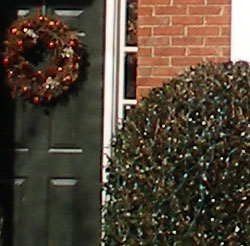
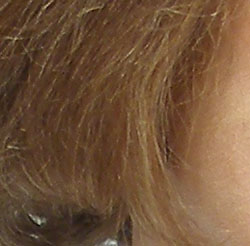
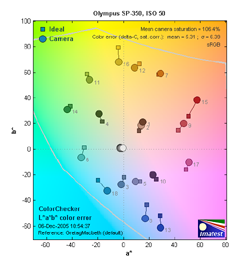


Follow Imaging Resource: